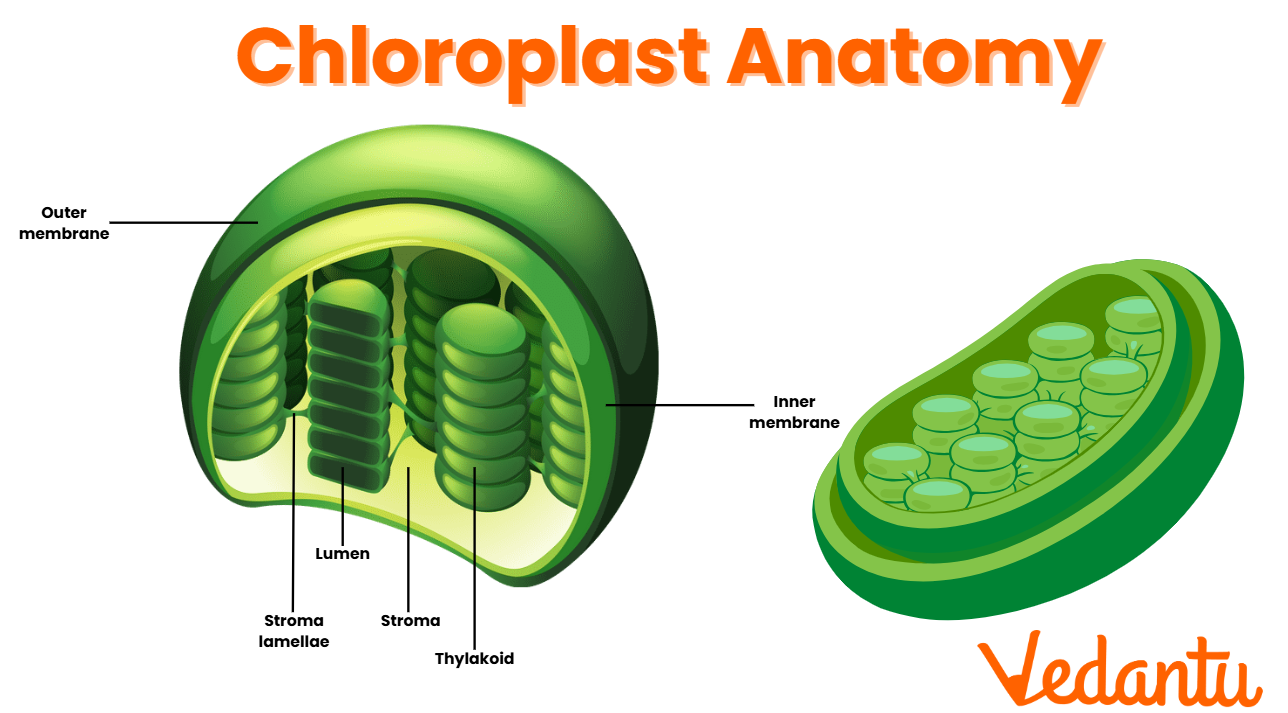What is a Chloroplast? The Key to Photosynthesis in Plants
Plants are the cornerstone of life on Earth, producing the oxygen we breathe and the food we eat. They are known as "producers" in the ecosystem, thanks to their ability to create energy-rich food through photosynthesis. A crucial component in this process is the chloroplast, an organelle found only in plant cells and some algae. In this guide, we will explore the chloroplast diagram, the structure of chloroplast, its functions, and more, to understand why these organelles are so essential to life.
Also Check: Cell Orgenelle
Chloroplasts – The Powerhouses of Photosynthesis
A chloroplast is a specialised organelle found in plant cells and algae. It is responsible for converting sunlight into energy through the process of photosynthesis, which produces oxygen and sugar. Chloroplasts are most commonly located in the mesophyll cells of leaves, where they absorb light to carry out their vital function.
Chloroplast Diagram – Labelled Simple Chloroplast Diagram
A labelled simple chloroplast diagram provides a clear visual representation of the chloroplast structure. It helps students understand the arrangement of the different parts of the chloroplast, such as the grana, stroma, thylakoids, and intermembrane space.
Read More: Thylakoids

Structure of Chloroplast
The structure of chloroplast is unique and essential for its role in photosynthesis. These organelles are oval or lens-shaped and are surrounded by a double membrane, consisting of an inner and outer membrane. Between these membranes is a space called the intermembrane space.
Inside the chloroplast, there are two main regions:
Grana: These are stacks of disc-shaped structures called thylakoids or lamellae. The grana contains chlorophyll, the green pigment that captures sunlight. This is where the light-dependent reactions of photosynthesis occur.
Stroma: The stroma is the fluid-filled space surrounding the grana. It contains enzymes, DNA, and ribosomes necessary for synthesising chloroplast proteins. It is the site of the Calvin cycle (the light-independent reactions of photosynthesis).
Parts of Chloroplast
The following are the key parts of a chloroplast:
Outer Membrane: This is the outer lipid bilayer that encloses the chloroplast.
Inner Membrane: A second lipid bilayer that encloses the stroma and separates it from the intermembrane space.
Intermembrane Space: The space between the inner and outer membranes.
Thylakoid Membrane: The membranes that form the thylakoid sacs within the grana. The chlorophyll pigment is embedded in these membranes, playing a crucial role in light absorption.
Stroma: The fluid-filled matrix where the Calvin cycle occurs, containing various enzymes and essential molecules for photosynthesis.
Grana: The stack of thylakoids increases the surface area for the light-dependent reactions.
Functions of Chloroplast
The primary function of chloroplasts is to conduct photosynthesis, a process in which light energy is converted into chemical energy. This occurs in two stages:
Light-dependent reactions: These reactions take place in the thylakoid membrane, where chlorophyll absorbs sunlight and uses it to split water molecules (photolysis), producing oxygen, ATP, and NADPH.
Calvin Cycle (Light-independent reactions): These reactions occur in the stroma, where carbon dioxide is fixed into glucose using ATP and NADPH produced during the light-dependent reactions.
Also Read:
Key functions of the chloroplast include:
Absorbing light energy and converting it into chemical energy
Producing oxygen as a byproduct of water-splitting
Producing ATP and NADPH, which are required for the Calvin Cycle
Generating sugars and other essential molecules for plant growth
Types of Chloroplast
Chloroplasts can be classified based on their function and appearance. While there are no distinct "types" of chloroplasts like there are for other plastids (e.g., chromoplasts and leucoplasts), chloroplasts can be modified depending on their role in the plant. They contain varying amounts of chlorophyll and may adapt to different environmental conditions, such as light intensity.
Why is Chloroplast Green?
The green colour of chloroplasts is due to the pigment chlorophyll, which absorbs light energy, particularly in the blue and red wavelengths. This pigment reflects green light, making chloroplasts appear green. Chlorophyll is essential for photosynthesis as it helps trap sunlight, which is the first step in the process.
Conclusion
Chloroplasts are vital to plant life and, by extension, all life on Earth. Their ability to conduct photosynthesis allows plants to produce energy, provide oxygen, and support the food chain. By understanding the structure of chloroplasts, their parts, and their functions, students can appreciate the complexity of plant cells and their role in sustaining life on Earth.
Read More:


FAQs on Chloroplasts - Structure, Functions, and Parts
1. Where does the photosynthesis process occur in the plant cell?
Photosynthesis occurs in the thylakoid membrane of the chloroplast.
2. What are the different parts of chloroplast?
The key parts of chloroplast are:
Stroma
Inner membrane
Outer membrane
Thylakoid membrane
Intermembrane Space
3. What is the most important function of chloroplast?
The most important function of chloroplasts is to synthesise food through photosynthesis, which produces glucose and oxygen.
4. Why is the chloroplast green?
Chloroplasts are green because of chlorophyll, the green pigment involved in photosynthesis.
5. How many types of plastids are there?
There are three types of plastids: chloroplasts, chromoplasts, and leucoplasts.
6. What is the stack of lamellae inside a plastid called?
The stack of lamellae inside a plastid is called grana.










